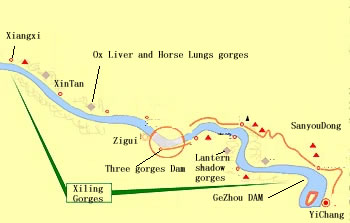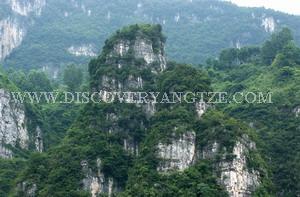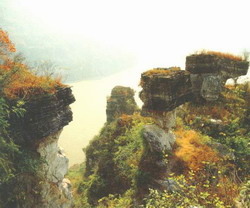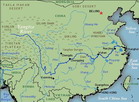2020 Yangtze River Cruise and Ferry Starting from 79 USD p.p.!
Xiling Gorge Introduction
Video A![]()
Video B![]()
Video C![]()
Xiling Gorge starts at Xiang Xi and zigzags for 76 kilometres (47 miles) down to Yichang . It is the longest and historically the most dangerous of the Yangtze gorges. Before the passage was made safe in the l950, 'the whole surface of the water was a swirling mass of whirlpools sucking the froth they created into their centres'. Xiling comprises seven small gorges and two of the fiercest rapids in the stretch of the Yangtze between Chongqing and Yichang.
made safe in the l950, 'the whole surface of the water was a swirling mass of whirlpools sucking the froth they created into their centres'. Xiling comprises seven small gorges and two of the fiercest rapids in the stretch of the Yangtze between Chongqing and Yichang.
On entering the western entrance the boat passes through the four-kilometre(2.4-mile) Iong Military Books and Precious Sword Gorge (Bingshu Baojian Xia).The name of the gorge refers to a stratified layer of rock resembling a stack of books,and a perpendicular rock shaft below it, at a small cave on the north bank. There are two stories told of these formations, both concerning heroes from the classical noveI Romance of the Three Kingdoms.
One legend has it that Zhuge Liang 181--234), military advi5er to the King of Shu, became  seriously ill while passing this way. Unwilling to entrust his valuable military treatises to any member of his entourage, he placed them up here on this inaccessible ledge, to be kept safe for later generations. The second tale is also about huge Liang. It was he who devised the stratagems which enabled Liu Bei, the king,to defeat the Kingdom of Chu and establish the, Minor Han dynasty (AD 22l--63).Afraid that he would eventually fall out of favour, Zhuge Liang retired from official life and went into seclusion, hiding his military writings and sword here.
seriously ill while passing this way. Unwilling to entrust his valuable military treatises to any member of his entourage, he placed them up here on this inaccessible ledge, to be kept safe for later generations. The second tale is also about huge Liang. It was he who devised the stratagems which enabled Liu Bei, the king,to defeat the Kingdom of Chu and establish the, Minor Han dynasty (AD 22l--63).Afraid that he would eventually fall out of favour, Zhuge Liang retired from official life and went into seclusion, hiding his military writings and sword here.
A large cleft rock stands at the mouth of a ravine--Rice Granary Gorge (MicangXia)--on the south side. Fine sand, blown by river winds, piles up O. this rock, and slowly sifts through a hole underneath. People call this Zhuge Liang's Granary.
Further on, the perilous Xin Tan (new rapid) rushes over submerged rocks, the oily surface of the water churned by whirlpools. In 1524, rock slides from the northern mountainside created this 3.2-kilometre, (l.9-mile) long, triple-headed rapid. The fall of the riverbed had been estimated at about 6 metres (20 feet), but today it has a drop of only 2 metres (6.5 feet).
When the water level was Iow, junks would unload their cargo and be hauled over by l00 or more trackers. Passengers would join their boat beyond the rapid afterwa1king along a wandering mountain track and passing through the village of Xintan,once the site of the White Bone Pagodaa giant pile of bleached bones, which was all that survived of the many thousands who had lost their lives at this frightening place. In l941 the steamboat MInxi came to grief and several hundred peopIe perished. The swift current carried boats downriver through Xin Tan at the rate of7 metres (30 feet) per second.
In 1854 a local merchant collected subscriptions from river traders and built three life-saving craft to patrol this rapid, and to salvage boats and survivors. This was the beginning of the Yangtze River Lifeboat Office, which eventually maintained its Redcoats on all the danger spots along the Chongqing--Yichang stretch until the 1940s.
The channel winds east and then south, towards Ox Liver and Horse Lungs Gorge, apparently. named after the yellow stalactite formations on the north side. One of the 'Horse's Lungs' is missing, blown up by British gunboats during the reign of Guangxu (1875--l908).
In the middle stretch of Xiling Gorge, the strangely lovely Kongling Gorge towers above the iron-green rocks of the 2.5-kilometre (1.5--mile) long KonglingTan, the worst of all the Yangtze rapids. Seventeen catastrophes involving steamships occurred here between l900 and l945. The larger boulders choking the channel had names such as 'Big Pearl', 'Monk's Rock' and 'Chickens' Wings', but the deadliest of all was known as 'Come to Me’.
As the boat enters Yellow Ox Gorge (Huangniu Xia)--said to look like a man riding an ox the passage widens out and sweeps under the ancient HuanglingTemPle (Huangling Miao) on the south face, nestling amid orange and pomelo trees.The great poet Du Fu wrote of his journey through this gorge :
Three dawns shine upon the Yellow Ox.
Three sunsets-and we go so slowly.
Three dawns----again three sunset-
And we do not notice that our hair is white as silk.
Huangling Temple, said to have been first built during the Spring and Autumn period (770--476 BC), is dedicated to the great Dayu who, with his ye1low ox, controlled the flood waters and dug the gorges . The present hall was built in the Ming dynasty (l368--l644) and houses a statue of Da Yu, as well as stone inscriptions. Zhuge Liang is also said to have dug the Yellow Ox Spring (or Toad Rock, as it is sometimes called) nearby. Its clear water, according to the Tang-dynasty Book of Teas, was excellent for the brewing of tea, and Yellow Ox was classified as the Fourth Spring under Heaven.
After one passes below Huangling Temple, the Bright Moon Gorge (MingyueXia) and the Lantern Shadow Gorge (Dengying Xia) loom ahead. The latter is overlooked on the south  Side by peaks in the shape of four figures from the l6th-centuryChinese novel, Pilgrimage to the West (also known as Monkey). When the evcningsun's rays fall upon these peaks, the figures do appear lifelike--Xuan Zang standingon the precipice edge; Monkey (Sun Wukong) peering into the distance; Sandy (ShaHeshang) carting the luggage, and Pigsty (Zhu Ba jie) riding a horse, all silhouetted against the fading light like characters in a shadow play.
Side by peaks in the shape of four figures from the l6th-centuryChinese novel, Pilgrimage to the West (also known as Monkey). When the evcningsun's rays fall upon these peaks, the figures do appear lifelike--Xuan Zang standingon the precipice edge; Monkey (Sun Wukong) peering into the distance; Sandy (ShaHeshang) carting the luggage, and Pigsty (Zhu Ba jie) riding a horse, all silhouetted against the fading light like characters in a shadow play.
The last of the smaller gorges is Yellow Cat Gorge (Huangmao Xia), so named from the yellow cat-shaped rock on the riverside. Qi Taigong Fishing is the namegfyen to a rock beside a cave on the south face, because of its fancied resemblance to a bearded old man wearing yellow trousers.
The vast construction site of the world's largest hydro-electric project, the Three Gorges Dam, offers the possibility of side trips to view the lock and ship lift mechanisms and an exhibition about the dam. Smaller ships descend via the single stage lift, and larger ones via a series of locks--a total of five when the waters have risen the full 110 metres (351 feet) above their previous levels.
Now the boat reaches the strategic So them Crossing Pass (Nanjin Guan), with Three Travellers' Cave above , marking the end of Xiling Gorge and the three great Yangtze gorges. The river widens dramatically and ahead lies Gezhou Demand Yichang.
The Gezhou Dam, impressive if first seen coming up-river, is now an anticlimax for those coming down. Nevertheless, it was China's largest before the construction of the Three Gorges Dam and a similar project on the Yellow River, and still produces 2.7l5 million kilowatts of electricity per hour. A single stage lock allows ships to descend to the level of Yichang.
• Xiling Gorges
• The Three Gorges Dam
• Tracking Through The Rapids



